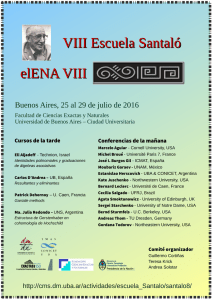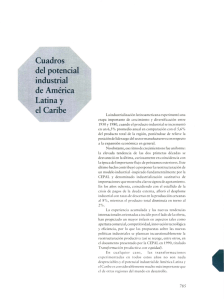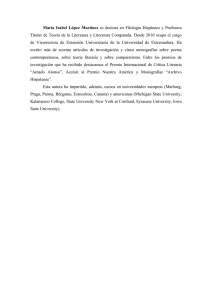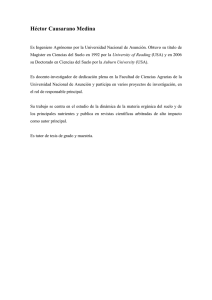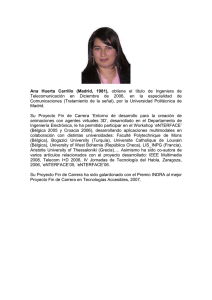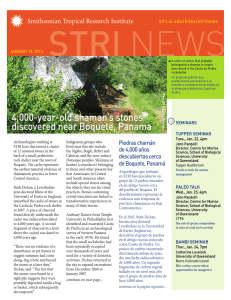how could climate change affect fiddler crab reproduction?
Anuncio
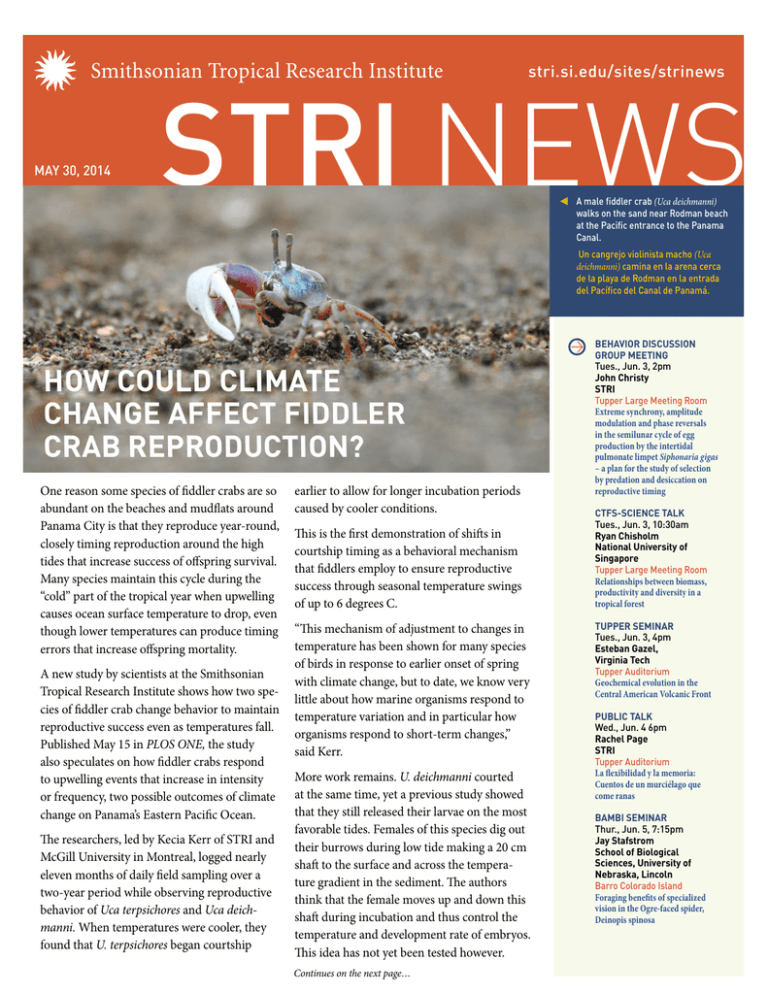
STRI NEWS stri.si.edu/sites/strinews MAY 30, 2014 A male fiddler crab (Uca deichmanni) walks on the sand near Rodman beach at the Pacific entrance to the Panama Canal. Un cangrejo violinista macho (Uca deichmanni) camina en la arena cerca de la playa de Rodman en la entrada del Pacífico del Canal de Panamá. HOW COULD CLIMATE CHANGE AFFECT FIDDLER CRAB REPRODUCTION? One reason some species of fiddler crabs are so abundant on the beaches and mudflats around Panama City is that they reproduce year-round, closely timing reproduction around the high tides that increase success of offspring survival. Many species maintain this cycle during the “cold” part of the tropical year when upwelling causes ocean surface temperature to drop, even though lower temperatures can produce timing errors that increase offspring mortality. A new study by scientists at the Smithsonian Tropical Research Institute shows how two species of fiddler crab change behavior to maintain reproductive success even as temperatures fall. Published May 15 in PLOS ONE, the study also speculates on how fiddler crabs respond to upwelling events that increase in intensity or frequency, two possible outcomes of climate change on Panama’s Eastern Pacific Ocean. The researchers, led by Kecia Kerr of STRI and McGill University in Montreal, logged nearly eleven months of daily field sampling over a two-year period while observing reproductive behavior of Uca terpsichores and Uca deichmanni. When temperatures were cooler, they found that U. terpsichores began courtship earlier to allow for longer incubation periods caused by cooler conditions. This is the first demonstration of shifts in courtship timing as a behavioral mechanism that fiddlers employ to ensure reproductive success through seasonal temperature swings of up to 6 degrees C. “This mechanism of adjustment to changes in temperature has been shown for many species of birds in response to earlier onset of spring with climate change, but to date, we know very little about how marine organisms respond to temperature variation and in particular how organisms respond to short-term changes,” said Kerr. More work remains. U. deichmanni courted at the same time, yet a previous study showed that they still released their larvae on the most favorable tides. Females of this species dig out their burrows during low tide making a 20 cm shaft to the surface and across the temperature gradient in the sediment. The authors think that the female moves up and down this shaft during incubation and thus control the temperature and development rate of embryos. This idea has not yet been tested however. Continues on the next page… BEHAVIOR DISCUSSION GROUP MEETING Tues., Jun. 3, 2pm John Christy STRI Tupper Large Meeting Room Extreme synchrony, amplitude modulation and phase reversals in the semilunar cycle of egg production by the intertidal pulmonate limpet Siphonaria gigas – a plan for the study of selection by predation and desiccation on reproductive timing CTFS-SCIENCE TALK Tues., Jun. 3, 10:30am Ryan Chisholm National University of Singapore Tupper Large Meeting Room Relationships between biomass, productivity and diversity in a tropical forest TUPPER SEMINAR Tues., Jun. 3, 4pm Esteban Gazel, Virginia Tech Tupper Auditorium Geochemical evolution in the Central American Volcanic Front PUBLIC TALK Wed., Jun. 4 6pm Rachel Page STRI Tupper Auditorium La flexibilidad y la memoria: Cuentos de un murciélago que come ranas BAMBI SEMINAR Thur., Jun. 5, 7:15pm Jay Stafstrom School of Biological Sciences, University of Nebraska, Lincoln Barro Colorado Island Foraging benefits of specialized vision in the Ogre-faced spider, Deinopis spinosa “By knowing the mechanism you discover the limits to adaptive responses,” said STRI’s John Christy, a co-author. “And by knowing limits you can make predictions about how changes in temperature — which are predicted to increase in extremes and frequency with changes in climate — will affect reproductive success and, ultimately, population persistence through time.” For example, what happens if temperatures change significantly during a reproductive cycle? U. terpsichores, which cannot change development rate once incubation begins, runs a greater risk of poorly timing larval release when compared to U. deichmanni, the researchers found. On the other hand, if prolonged coldwater upwelling events are in the cards for climate change, “U. terpsichores should be able to adjust but, even if U. deichmanni females regulate temperature behaviorally, the limits of their thermoregulatory ability may be surpassed,” they conclude. ¿CÓMO PODRÍA EL CAMBIO CLIMÁTICO AFECTAR LA REPRODUCCIÓN DEL CANGREJO VIOLINISTA? Una razón por la que algunas especies de cangrejos violinistas son tan abundantes en las playas y marismas cerca de Ciudad de Panamá es porque se reproducen durante todo el año, coordinando muy de cerca el momento de la reproducción alrededor de las mareas altas que aumentan el éxito de supervivencia de las crías. Muchas especies mantienen este ciclo durante la parte “fría” del año tropical cuando el afloramiento hace que la temperatura superficial del océano baje, a pesar de que las temperaturas más bajas pueden producir errores en la coordinación que aumentan la mortalidad de las crías. Un reciente estudio realizado por científicos del Instituto Smithsonian de Investigaciones Tropicales muestra cómo dos especies de cangrejos violinistas cambian su comportamiento para mantener el éxito reproductivo, incluso cuando las temperaturas bajan. Publicado el 15 de mayo en PLOS ONE, el estudio también especula sobre cómo los cangrejos violinistas responden a los eventos de surgencias que aumentan en intensidad o frecuencia, dos resultados posibles del cambio climático en el Océano Pacífico Oriental de Panamá. Los investigadores, liderados por Kecia Kerr, del Smithsonian en Panamá y la Universidad de McGill en Montreal, han registrado casi once meses de muestreo de campo diario durante un período de dos años, mientras observaban el comportamiento reproductivo de los Uca terpsichores y los Uca deichmanni. Cuando las temperaturas eran más frías, se encontraron con que los U. terpsichores iniciaban el cortejo antes para permitir períodos de incubación más largos debido a condiciones más frescas. Esta es la primera demostración de los cambios en la sincronización del cortejo como un mecanismo de comportamiento que los STRI NEWS, MAY 30, 2014 McGill’s Kecia Kerr works at Punta Culebra beach in this file photograph. Kecia Kerr de McGill trabaja en la playa de Punta Culebra, en esta fotografía de archivo, violinistas emplean para asegurar el éxito reproductivo a través de los cambios de temperatura estacionales de hasta 6 grados C. “Este mecanismo de ajuste a los cambios de temperatura se ha demostrado para muchas especies de aves en respuesta a la aparición más temprana de la primavera con el cambio climático, pero hasta la fecha, se sabe muy poco acerca de cómo los organismos marinos responden a las variaciones de temperatura y en particular cómo los organismos responden a los cambios a corto plazo”, comentó Kerr. Queda más trabajo por hacer. Los U. deichmanni cortejaron al mismo tiempo, sin embargo, un estudio anterior mostró que aun así liberaron sus larvas en las mareas más favorables. Las hembras de esta especie excavan sus madrigueras durante la marea baja haciendo un pozo de 20 cm de largo a la superficie y en todo el gradiente de temperatura en el sedimento. Los autores creen que la hembra se mueve de arriba a abajo de este pozo durante la incubación y por lo tanto controla la temperatura y la taza de desarrollo de los embriones. Sin embargo esta idea aún no ha sido probada. “Al conocer el mecanismo descubres los límites de las respuestas de adaptación”, comentó John Christy del Smithsonian en Panamá y co-autor. “Y al conocer los límites, puedes hacer predicciones sobre cómo los cambios en la temperatura - que se prevé que aumenten en los extremos y la frecuencia con los cambios en el clima - afectarán el éxito reproductivo y, en última instancia, la persistencia de la población a través del tiempo.” The illustration shows fiddler crab reproduction from courtship (A) and mating (B) to incubation (C) and ideal larval release at night (D), compared with a daytime larval release scenario during the day (E), which would increase chances of predation. La ilustración de muestra la reproducción del cangrejo violinista desde el cortejo (A) y el apareamiento (B) de la incubación (C) y la ideal liberación de larvas durante la noche (D), en comparación con un escenario diurno de liberación de larvas durante el día (E) que aumentaría las posibilidades de depredación. Por ejemplo, ¿qué sucede si las temperaturas cambian significativamente durante el ciclo reproductivo? Los investigadores descubrieron que el U. terpsichores, que no puede cambiar la tasa de desarrollo una vez que comienza la incubación, corre un mayor riesgo de mala coordinación de liberación de las larvas en comparación con el U. deichmanni. Por otro lado, si los eventos de surgencia de aguas frías prolongados están en las cartas para el cambio climático, “el U. terpsichores debería ser capaz de adaptarse, pero incluso si las hembras de U. deichmanni regulan la temperatura a manera de comportamiento, los límites de su capacidad de termorregulación pueden ser superados,” concluyen. John Christy observes fiddler crabs at Rodman beach during a field trip in 2013. John Christy observa los cangrejos en la playa de Rodman durante una gira de campo en el 2013. Photo by Sean Mattson - STRI WE WILL MISS YOUR SMILE! ¡ECHAREMOS DE MENOS TU SONRISA! Doris Jaen, our former colleague, mother of Alfredo and Pablo, and wife of Conrado Tapia, Research Assistant in Richard Cooke’s lab, died on May 29 after a battle with cancer. Doris began her career at STRI in 1991 as part of the Oil Spill Project. Later she became the manager of the STRI Bookstore. In 2003, she took over the Accounts Payable position in the Accounting Department. More recently, she was responsible for Cash Management. In Sept. 2013, Doris decided to leave STRI to spend more time with her family. Doris Jaén, nuestra antigua colega, madre de Alfredo y Pablo, y esposa de Conrado Tapia, Asistente de Investigación en el laboratorío de Richard Cooke, falleció el 29 de mayo después de una batalla contra el cáncer. Doris inició su carrera en STRI en 1991 con el Proyecto de Derrame de Petróleo en las oficinas de Naos. Luego se desempeñó como gerente de la librería. En el 2003 pasó al Departamento de Contabilidad como encargada de Cuentas por Pagar. Más tarde se hizo cargo de la Sección de Tesorería. En septiembre del 2013, Doris decidió dejar STRI para pasar más tiempo con su familia. Adriana Bilgray’s comment when she nominated Doris for a PRIDE award in 2008 expresses a common sentiment: “Doris is one of the most positive people at STRI. I have NEVER heard her complain and she is ALWAYS in a good mood.” On behalf of the STRI family, our thoughts and hearts are with Conrado and her sons. We are happy to have had the good fortune to work with such a positive, loving human being. Photo by Alfredo Martiz El comentario de Adriana Bilgray cuando Doris fue nominada para un premio de PRIDE en el 2008 expresa un sentimiento común: “Doris es una de las personas más positivas en STRI. JAMÁS la he escuchado quejarse y SIEMPRE tiene la mejor disposición.” En nombre de la familia de STRI, nuestros pensamientos y corazones están con Conrado y sus hijos. Estamos contentos de haber tenido la suerte de trabajar con un ser humano tan positivo y amoroso. IS FOREST FRAGMENTATION DRIVING VIRUS EMERGENCE? ¿ES LA APARICIÓN DE LOS VIRUS IMPULSADA POR LA FRAGMENTACIÓN DE LOS BOSQUES? Photo by Sean Mattson - STRI Marco Marklewitz sometimes starts experiments in his gumboots. When his colleagues’ socks are ripe for a washing, his instead are put in a mosquito trap and hoisted into the tropical forest canopy. In a quest to catch as many of Panama’s 280-plus mosquito species as possible, the virology grad student from the University of Bonn in Germany needs to be creative. “You see a significant difference in species diversity between the worn socks and the artificial attractants,” said Marklewitz after checking traps on a tiny island in the Panama Canal. Marklewitz’s research is part of a multidisciplinary disease ecology project funded by the German Research Foundation. Alongside colleagues who work with rodents and bats, Marklewitz studies how habitat fragmentation influences the prevalence and diversity of viral infections. Fragments are thought to have lower diversity but greater STRI NEWS, APRIL 4, 2014 numbers of common species, including mosquitos. This leads to the presence of a higher number of viruses associated with these species. “Viruses mutate fast – especially when they occur in high numbers. We hypothesize that the likelihood of mutations that may cause a species jump is tremendously higher in fragments than in an intact ecosystem,” he said. Research sites include two types of fragmentation - islands and forests surrounded by pasture - as well as contiguous secondary and remote, old-growth forests. Photo: Sean Mattson “Remote forests can help us understand virus evolution if we find ancestors of a virus in those pristine habitats,” said Marklewitz, who plans to catch some 15,000 mosquitos. Marco Marklewitz a veces inicia sus experimentos en sus botas de goma. Cuando los calcetines de sus colegas están listos para una lavada, el en cambio coloca las suyas en el dosel del bosque para atrapar mosquitos. En su búsqueda por capturar la mayor cantidad posible de las 280+ especies de mosquitos existente en Panamá, este estudiante de post grado en virología de la Universidad de Bonn en Alemania tiene que ser creativo. “Uno observa una diferencia significativa en la diversidad de especies entre las medias usadas y los atrayentes artificiales”, comentó Marklewitz después de revisar las trampas en una pequeña isla en el Canal de Panamá. La investigación de Marklewitz es parte de un proyecto multidisciplinario de ecología de las enfermedades financiado por la Fundación Alemana para la Investigación. Junto a colegas que trabajan con roedores y murciélagos, Marklewitz estudia cómo la fragmentación del hábitat influye en la prevalencia y la diversidad de las infecciones virales. Se cree que los fragmentos tienen diversidad más baja, pero un mayor número de especies comunes, incluyendo a los mosquitos. Esto conduce a la presencia de un mayor número de virus asociados con estas especies. “Los virus mutan rápidamente - especialmente cuando ocurren en grandes cantidades. Nuestra hipótesis es que la probabilidad de mutaciones que pueden causar un salto en la especie es tremendamente superior en fragmentos que en un ecosistema intacto”, comentó. Los sitios de investigación incluyen tipos de fragmentación - islas y bosques rodeados de pastos - así como bosques contiguos secundarios y remotos, bosques maduros. “Los bosques remotos pueden ayudarnos a comprender la evolución del virus si encontramos antepasados de un virus en esos hábitats prístinos”, comentó Marklewitz, quien planea captar unos 15,000 mosquitos. ARRIVALS Emma Tower Kim Hunter Bernd Meyer and Martin Burd Conflicts among members of interacting symbioses: How do symbiotic fungi influence plant defense against leaf-cutting ants? Gamboa Multi-modal communication Gamboa Sequential transport and information transfer in leaf-cutter ants Barro Colorado Island Tulane University Jeremy La Che University of Wisconsin – Milwaukee Do lianas cause chronic disturbance and alter successional trajectories in tropical forests? Barro Colorado Island James Moran and Michael Kovalchik University of Scranton Ecology and species barriers in emerging viral diseases Barro Colorado Island Antoniya Hubancheva National Museum of Natural History Predator foraging behavior Gamboa Jelena Bujan University of Oklahoma Experimental MacroEcology-the kinetics of biodiversity in soil microbes and invertebrates Barro Colorado Island Alex Henderson Butler University Field Course - Terrestrial Tropical Ecology / Butler University 2014 Gamboa and Barro Colorado Island Salisbury University Nicolas Chatel-Launay McGill University Natural history of panamanian Cassidine beetles Tupper Laura Bravo Universidad de los Andes, Colombia Parent-embryo interactions in Neotropical glassfrogs (Centrolenidae) – Amendment Gamboa Matthew Sayre University of South Dakota Phenotypic plasticity and variability in teosinte, maize’s wild ancestor, in experimental early Holocene environments Center for Tropical Paleoecology Maria Rodríguez-Ronderos University of Wisconsin – Milwaukee Monash University Frauke Barthold University of Postdam Surficial processes in undisturbed forests and their controls Barro Colorado Island Jillian del Sol Tulane University When do divergent mate preferences lead to reproductive isolation? Bocas del Toro Robert Oppenheimer George Washington University Marc Seid, Ashley Villa and Erika Sarno University of Scranton Social biology of the bee, Megalopta Barro Colorado Island Quantifying varying levels of liana infestation on tree growth, fecundity, and survival Barro Colorado Island Eloisa Lasso Venus Kuo Instituto Alexander von Humboldt University of Illinois UrbanaChampaign Seed defense syndromes of tropical forest trees: Emergent properties of seed dormancy, defense and microbial interactions Tupper and Barro Colorado Island Universidad de los Andes, Colombia Barrett Klein University of Wisconsin La Crosse Clarice Diebold Dalhousie University Unlocking the mysteries of sleep: improved learning as a shared functional benefit Gamboa Gwen Keller COPEG Cecilia de Escobar and Julivet Núñez Instituto de Investigacion Agropecuaria de Panama MMUL - Molecular Multiuser Laboratory Naos Marine Lab Valeria Gómez Centro de Ecología Aplicada del Litoral Karen Warkentin and Sonia Perez Boston University Development, behavior, and adaptive plasticity at life history switch points Andrea Paz The role of somatic mutation, frequency-dependent mortality and mating patterns in generating and maintaining genetic diversity in clonal populations DEPARTURES Rachel Collin To La Serena, Santiago, Chile for the project Biased evolutionary transitions in mode of development: Can differences in morphology and digestive function be linked to evolvability of gastropod development? Ben Turner To Jeju, Korea and Chengdu, China To attend the World Soil Science Congress in Korea, and to visit the Hailuogou glacial chronosequence in Chengdu, China Carlos Jaramillo To Barranquilla, Colombia To give a talk in the Biodiversity workshop organized by Universidad del Norte Andrew Altieri To Bocas del Toro To monitor and establish experiments at field sites in the area Raúl De León To Bocas del Toro For a monthly visit, service and maintenance of the dive compressor and scuba tank Catherine Potvin To Alto Bayano, Darien For the Bayano Film Festival and Workshop -with participants of the three groups participanting in the project Mac (Emberá, kunas, campesinos). Jacob Slusser To Quindio, Colombia To participate and organize the ELTI workshop called Ecological Restoration in Cattle Ranching landscapes. PUBLICATIONS Aronson, R. B., Hilbun, N. L., Bianchi, T. S., Filley, T. R. and McKee, B. A. 2014. Land use, water quality, and the history of coral assemblages at Bocas del Toro, Panamá. Marine Ecology Progress Series, 504: 159-170. doi:10.3354/ meps10765 Laurance, W. F., Andrade, A. S., Magrach, A., Camargo, J., Campbell, M., Fearnside, P. M., Edwards, W., Valsko, J. J., Lovejoy, T. E. and Laurance, S. G. 2014. Apparent Environmental Synergism Drives the Dynamics of Amazonian strinews@si.edu Forest Fragments. Ecology, doi:10.1890/14-0330.1 O’Mara, T. M. and Hickey, C. M. 2014. The development of sex differences in ringtailed lemur feeding ecology. Behavioral Ecology and Sociobiology, doi:10.1007/ s00265-014-1738-3 Schnitzer, Stefan A., van der Heijden, G.,M., Mascaro, J. and Carson, W. P. 2014. Lianas in Gaps Reduce Carbon Accumulation in a Tropical Forest. Ecology, doi:10.1890/13-1718.1 Questions/comments Preguntas/comentarios @stri_panama #smithsonian
